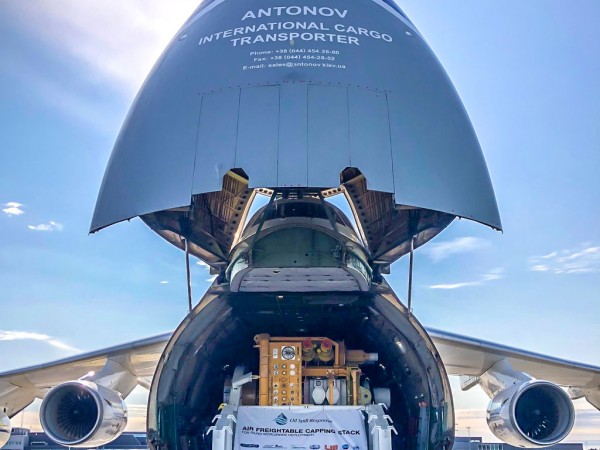ANTONOV Airlines works with Chapman Freeborn Airchartering and Oil Spill Response Limited to test the airborne transport of a capping stack for the first time
London, UK - ANTONOV Airlines and Chapman Freeborn Airchartering have taken part in a ground-breaking test flight to transport by air, instead of by sea, a capping stack, which is the vital equipment used by the oil industry in the event of an oil spill.
ANTONOV, working with charter specialist Chapman Freeborn and its client Oil Spill Response Limited (OSRL), deployed an AN-124 to carry the fully assembled subsea capping stack and housing, which weighed a massive 85.5 tonnes and measured 11.5 by 5.5 by 3.9 metres.

“This was a very important test flight, as this represents the first time anyone has transported a capping stack on an aircraft that would be used in the event of an oil spill emergency, enabling a much quicker response anywhere in the world,” said Martin Griffiths, Sales Manager at the UK office ANTONOV Airlines.
“We faced a variety of challenges including limited clearance for the cargo, the weight and size of the capping stack itself and its effect on the flight, as well as the requirement to load it fully assembled, as would have to be the case in an actual oil spill scenario,” explained Griffiths.
The AN-124 was chosen for the flight after an extensive logistics study by Chapman Freeborn. Its ability to travel up to 5,000km with a 120-tonne payload, self-loading/off-loading capabilities, which removes the necessity for a main deck loader, and availability on the European spot market cemented the choice.
To enable the movement of the capping stack in a single operation, OSRL worked with L+M to design and build a bespoke frame, with support from Trendsetter, the capping stack manufacturer.
The efforts were also supported by the engineers from ANTONOV Company’s design bureau, who ensured proper distribution of the capping stack weight along the cargo cabin floor and acceptable minimal clearances from the cabin frames.
ANTONOV Airlines also reviewed and approved the stress levels of the combined skid/capping stack design for the maximum flight G-forces.
Chris Lund, Technical Manager for OSRL's SWIS team, said: “When every minute counts, the number one priority is stopping the flow of hydrocarbons as quickly as possible. The ability to transport a fully assembled capping stack by air is a critical development for the industry.”
“Sea transport remains the most likely mobilisation option for the majority of well sites, but for wells in more remote areas, this is a vital addition to our subsea capping and containment offering,” he added.
Daniel Carriett, Director of Cargo Operations at Chapman Freeborn, added: “Chapman Freeborn has worked with OSRL for many years and we’re proud to have been involved in this industry first test flight.
“We’re delighted to have successfully managed the project for our client and would like to thank ANTONOV and all of the other parties involved for their professionalism and support.”









